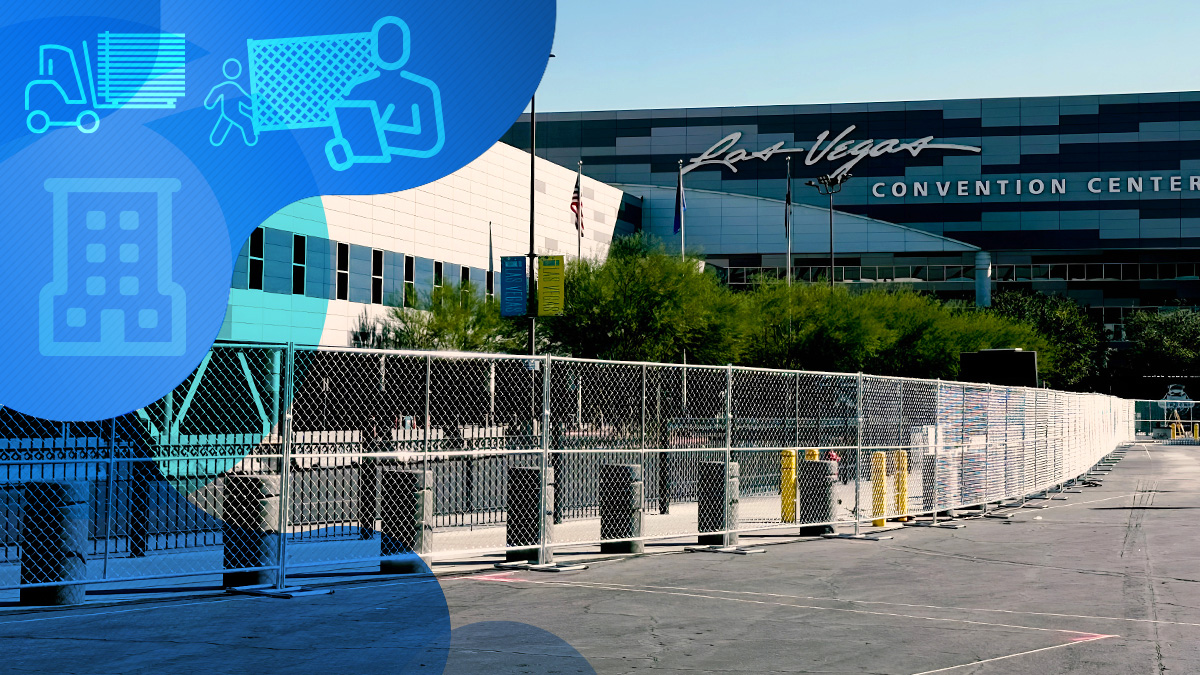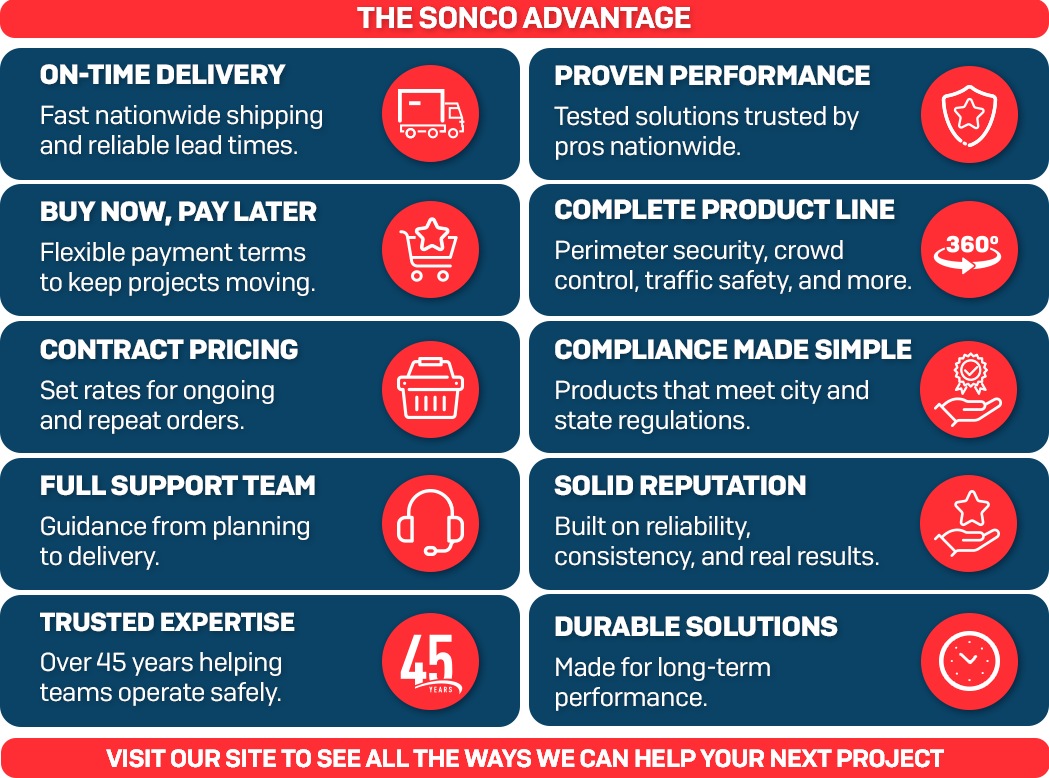Temporary Fence Rental Pricing Guide
Setting the right price for your temporary fence rental service can make or break your business. From fence types to location and rental duration, we covered the essential factors to help you set competitive and fair prices.

Pricing your temporary fence rentals wrong can kill your profits.
Charge too little, and you’ll barely break even. Charge too much, and customers will look elsewhere.
The sweet spot that you're looking for is an amount that delivers a fast return on your investment and allows you to hire quality workers.
So how do you find the perfect balance? This guide breaks it down.


Temporary Fence Rental Cost Factors
Temporary fence pricing is not one size fits all.
For example, rentals can take place over varying lengths of time and may involve add-ons to deliver value to the customer, while adding to the cost.
All these factors and more must be considered when determining costs for the client.
Fence Type
Some customers need chain-link fencing to protect their construction jobsite, while others prefer the looks of welded wire panels.
Some may even want barricades to control traffic at their special event. Privacy fences, security fencing, fencing with barbed wire - all are available at varying price points.
Basic temp fence rentals typically involve chain-link fencing in 10' or 12' panels, with tube footing and weights at the bottom to improve stability.
Other products are usually available at a higher cost.
When you're pricing a product, consider the cost of purchase to guarantee fast ROI.
Inventory Costs & Supplier Partnerships
The upfront cost of purchasing temporary fencing directly impacts rental pricing and profitability.
A chain-link fence panel starter kit, including panels, stands, and hardware, can cost around $129, though prices fluctuate.
Many businesses rent panels for $30 to $50 per month, typically making back their costs after three or four rentals. Longer-term rentals can speed up this process.


One way to keep costs down is by partnering with the right supplier.
SONCO offers bulk discounts on temporary fencing, helping rental businesses maximize profitability.
Additionally, we work with our partners to streamline their inventory purchases—allowing them to secure a customer first and then order materials using the client’s down payment.
This means your first rental can have a significantly lower upfront cost.
To further simplify operations, SONCO can also deliver fencing directly to your customer’s location.
This reduces the need for immediate storage, making it easier to launch and scale your rental division.
Location
Installation is easier in some locations than others.
When evaluating a location to determine the installation fee, pay attention to the terrain and access points.
How many workers will it take to install the temp fence in this location?
How long will it take them? Will temp fence installation require special equipment in this location? Can equipment like your trucks, forklift, and other tools be used in this location? Does the location contain any hazards?
All of these factors will affect how long it takes to install the fencing, which in turn should impact the fee for installation and removal.
Consider all the questions above when determining installation and removal fees.
Perimeter Size
The larger the perimeter, the more panels will be needed, the more time it takes to install the temporary fence, and the more workers are required to do the job. Like the location, this impacts installation fees and can affect the overall cost of the rental.


Ground Type
It's harder to install temporary fencing on uneven ground or on sandy terrain. In these places, workers take longer to do their job. Uneven ground can also make installation more difficult, because stabilizing temporary fencing is more difficult in these areas. Pay attention to ground type, including how level and sturdy it is.
Length of Rental
Typically, a longer rental term is more cost-efficient than a short one - for both the renter and the rental company. Hourly or daily rentals cost more for the length of time, while those that happen by the week or month are comparatively much cheaper. Give discounts for longer rentals to encourage customers to keep their fencing as long as needed.
Rental Season
Many temporary fence rental companies have busy and quiet seasons. Rentals still occuer in the quiet season, but not as many.
Many fence rental companies drop their prices when demand goes down.
It's easier to install, uninstall and maintain fences when there are fewer customers and fewer jobs all around.
Offering long-term rental discounts is another way to secure steady revenue even during slower seasons.
Keep in mind that during this time, you may also have a smaller crew with few or no seasonal workers. This reduces business costs and enables you to charge lower prices.
Accessories
Are you installing a padlock? A privacy screen? A gate? Anchor Weights?
These products cost extra money, which adds to the total cost of the rental.
Some accessories (like padlocks) may represent a one-time only charge, while other accessories (like a gate) might add to the cost per month.
Customer Rewards and Loyalty Programs
It's important to reward good customers for their loyalty. Set up a customer rewards, loyalty program, or referral program to reward customers for their business.


What to Charge for a Fence Rental Service
Now that we've discussed the factors that affect cost, it's time to talk about current pricing for your temporary fence rental business.
How to Find the Market Price
The market price for fence rental varies by location.
Doing market research for your area can help you determine how much to charge for your services.
- Know the average price of fence rentals in your area. Different companies structure their pricing in different ways, but pay attention to the overall cost of renting basic fencing for typical periods (a weekend, a week, a month). Request quotes from your competitors and assemble the information in a chart so you can review it easily.
- Analyze the demand. Who are the customers in your area, and what are their needs? Having this information can help you set competitive prices and create deals that will attract customers to your company.
- Consider the cost of labor, including how much time it takes your workers to put up and tear down fencing. Once your fencing pays for itself, the rental fees will help cover the cost of labor.
- Consider the cost of storage in your location. The more you pay for storage fees and other related costs, the more you'll have to charge for your service.
Installation and Removal Fee
Installation and removal fees vary, but typical fence rental companies charge between $50 and $100 per hour.
Consider the number of workers and the job's complexity when charging the installation fee.
When writing the contract, don't forget to charge for installation and removal up front.
To do this, one option is to estimate the amount of time it will take to install and remove the fence, and charge the renter a flat fee.
Alternatively, you can also charge an hourly rate for installation, then double the cost to cover removal.
Freight Costs
Don't forget to charge for freight (the cost to deliver fencing to the site), either per mile or as a flat fee.
This helps cover the cost of fuel, distance traveled, vehicle maintenance, and so on.
Maintenance Fee
Long-term rentals typically require maintenance to keep the fence stable and in good condition.
In this case, a maintenance fee applies to pay for your time and energy spent inspecting, repairing, or replacing due to wear and tear on your product.
Monthly, Weekly, or Daily Charges
Generally, the cost per day goes down as the rental period grows longer.
It's easier to recover your costs when there's a lot of downtime between the installation and removal of your fencing.
Establish a graduated price structure, where prices go down as the term of the rental increases.


Pricing Strategies
There are many pricing strategies you can follow to set prices for your fence rental company. Some examples:
- Cost plus margin. Cost plus margin is a cost structure that considers the cost of the product plus maintenance, repairs, insurance, storage, and administrative expenses. Once all of these costs are considered, a margin for profit is built into the rental price.
- Percentage of cost. The 2% rule is a real estate pricing strategy that states the price of a rental property should be kept at 2% of the property's value. A similar tactic - charging a percentage of the cost of the product - could be applied to fence rental. However, this strategy doesn't consider the market conditions in your area, who your customers are, the demand for service in your area, and so on. Overall, it's best to have a reason for choosing the price of your product, so a more thoughtful price structure may be appropriate for your rental business.
- Price for fast ROI. Smart pricing of your product can help you recover the cost of purchase more quickly. If you're a new fence rental business, it's important to pay for your fence rental materials as soon as possible. Renting fencing at $2-$5 per linear foot will typically recover the cost of the product in around 3 to 4 rentals.
- Charge for extras. Does your customer need a vehicle gate? Pedestrian gate? Privacy screen? Know how much to charge for these extras. Establish a rate sheet that accounts for all these add-ons.
Whichever strategy you choose, SONCO can help simplify the process with our Temporary Fence Rental Calculator. Instead of manually working through pricing variables, this tool delivers precise cost estimates based on project scope, helping rental companies refine their pricing or contractors manage budgets effectively.
With a clear breakdown of costs, you can make informed decisions, avoid pricing miscalculations, and boost profitability. Take the guesswork out of pricing—download SONCO’s Temporary Fence Rental Calculator today!


Improve Your Pricing Strategy with Value-Added Accessories
While setting competitive rates for temporary fence rentals is essential, don’t overlook the potential to increase your bottom line with smart add-ons.
Accessories like privacy screens and branded fence screens not only improve your service offering but also create an opportunity to significantly increase your revenue.
By including these value-added options in your pricing strategy, you can offer your customers more while improving your overall ROI.
To help you take full advantage of this opportunity, we’ve developed a FREE guide on Increasing Your Revenue with Fence Screen Reselling.
This comprehensive resource walks you through the benefits of integrating fence screens into your rental packages, provides actionable reselling strategies, and shows you how to price these add-ons for maximum profitability.
Download the free guide now and learn how to improve your temporary fence rental business by turning accessories into an extra revenue stream.


Grow Your Temporary Fence Rental Business
One more tip as your temporary fence business takes off: keep evaluating pricing as your business grows.
Market conditions can change, and your business will change as well. Pay attention to customer feedback and consider your most popular rentals to adapt prices accordingly.
Growing your temporary fence rental business starts with good pricing, but it doesn't end there.
Evaluate all your decisions periodically, not just pricing. Paying attention to what works and what doesn't can help you find success.
Continue to grow your business through thoughtful leadership, smart decision making, and other practical tips listed here in this guide!
Email us at sales@soncostore.com or call 866-254-6510 for a quick quote or any help you need.




Trend now

Fence Privacy Screen: The Missed Revenue for Rental Companies
Grow profits by over 100% with fence privacy screens. See the numbers, customer benefits, and how SONCO makes it simple.

Greener Shows, Greater Impact: Sustainability in the Live Music Industry
In a competitive market where experience and perception impacts attendance, sustainability is a business advantage as well as a moral responsibility.

Parking Lot Safety Tips for Venues and Arenas
A safe and efficient parking lot sets the tone for the entire event experience, starting from the moment guests arrive.












